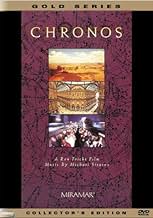Comparisons between "Chronos" (1985) and "Koyanisqaatsi "(1982) are rather inevitable. Both films were written and shot by Ron Fricke, who also directed "Chronos." (Godfrey Reggio directed "Koyanisqaatsi"). Both films are filled with richly poetic images of pristine natural settings counterpointed with man's intrusion into those settings and the evolution of his civilization. As a great admirer of "Koyanisqaatsi," these commonalities are what drew me recently to watching "Chronos" on HD home video. Unfortunately, the comparisons pretty much end there.
"Chronos" is a much less satisfying undertaking. Not only is it merely half the length of its cult-classic predecessor, but it's less than half the film in terms of ambition and coherent vision as well. Whereas "Koyanisqaatsi" had a strong (some would say heavy-handed) political and philosophical message concerning man's corrupting - even diabolical - impact on the globe, "Chronos" doesn't seem to have much point at all behind its slide show alternation of natural and man-made imagery.
To be fair, the film does clearly communicate the notion that the relatively short history of human civilization has bequeathed many majestically beautiful works of art and other grand artifacts, from awe-inspiring pyramids and cathedrals to the great sprawling cities of the world like New York and Paris. Yet, if the point of the film was in part to redress the extremely negative view of man's "progress" delivered by "Koyanisqaatsi," it just doesn't come across very strongly. And, if re-balancing was the point, then what is the audience supposed to make of the frequent used of accelerated motion that suggests to me not only the passage of time alluded to in the film's title but also that man's course has been too rapid and perhaps reckless? It just doesn't add up.
Like "Koyanisqaatsi," "Chronos" relies entirely on image and music to structure its minimal narrative. Neither film offers plot or character in a conventional sense, but "Koyanisqaatsi" manages nevertheless to forge drama by progressively intensifying the conflict of its man versus nature imagery. "Koyanisqaatsi" also benefits from a much more powerful score and from its Native American titular keyword, chanted repeatedly as a choral expression of the film's simple but abstract theme that indeed "life is out of balance." "Chronos" could definitely have benefited from similar devices to give its imagery thrust and significance.
Instead, "Chronos" is essentially a glorified image music piece. Not that there's anything wrong with that. Many of its images are arresting and some - like the city nightscapes - are breathtaking. Though I think not part of its intent, "Chronos" also offers parlor-game amusement for anyone trying to identify the cornucopia of natural, artistic, and architectural wonders that pour past one's eyes. All in all, the film is a pleasurable but forgettable viewing experience.






















